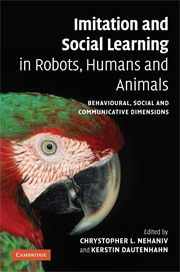 Imitation and Social Learning in Robots, Humans and Animals
Imitation and Social Learning in Robots, Humans and Animals Published online by Cambridge University Press: 10 December 2009
The question of why animals, humans and robots should or do engage in social learning or social matching behaviour has at least two major answers: learning and communicative interaction (Užgiris, 1981). The link between the motivations for imitative behaviour and development are the common theme of the two chapters in this section of the book. The former, acquisition of new behaviours via observational learning (Bandura, 1977), has been better studied, the latter motivation for behaviour matching less so, but it clearly plays a communicative role when turn-taking, role-taking, being imitated and topic-sharing occur in communicative social interactions of pre-verbal young children (Nadel et al., 2002), compare Part V, Synchrony and turn-taking as communicative mechanisms, in this volume.
Psychologists Mark Nielsen and Virginia Slaughter discuss results on the development in human children of different types of imitative capacities including immediate, deferred and synchronic imitation, and the capacity to imitate after having observed incomplete or failed behaviours. Following Užgiris and Nadel, they discuss the development of imitation for interactive and communicative functions, where imitation is ‘conceived fundamentally as a social act’, as opposed to its role in skill learning. They assess evidence from their own experiments and the studies of others on imitation as a communicative mechanism. Here imitation serves to initiate and maintain social engagement, for example, in turn-taking games. The importance of various factors such as attention to actions or attention to the model, as well as vocal imitation are also discussed.
To save this book to your Kindle, first ensure no-reply@cambridge.org is added to your Approved Personal Document E-mail List under your Personal Document Settings on the Manage Your Content and Devices page of your Amazon account. Then enter the ‘name’ part of your Kindle email address below. Find out more about saving to your Kindle.
Note you can select to save to either the @free.kindle.com or @kindle.com variations. ‘@free.kindle.com’ emails are free but can only be saved to your device when it is connected to wi-fi. ‘@kindle.com’ emails can be delivered even when you are not connected to wi-fi, but note that service fees apply.
Find out more about the Kindle Personal Document Service.
To save content items to your account, please confirm that you agree to abide by our usage policies. If this is the first time you use this feature, you will be asked to authorise Cambridge Core to connect with your account. Find out more about saving content to Dropbox.
To save content items to your account, please confirm that you agree to abide by our usage policies. If this is the first time you use this feature, you will be asked to authorise Cambridge Core to connect with your account. Find out more about saving content to Google Drive.